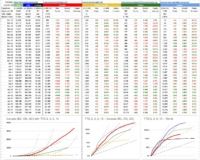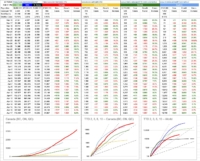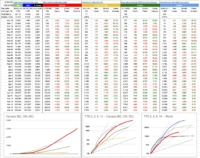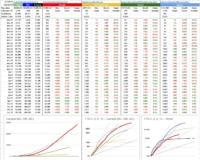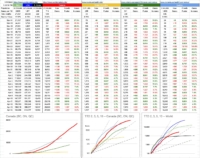Share...
Day 33 – April 18, 2020
Did you know that the bubonic plague is still around? That pesky little bug that killed up to 200 million people in the Middle Ages still pops up from time to time. A boy in Idaho got it a couple of years ago, I kid you not.
“Hey Jimmy, what’d you do all Summer?”
“Actually, I was sick for most of it with bubonic plague”
It’s almost worth getting, just so you can bring it up in Show’n’Tell. So much better than “Visited the grandparents in Wichita and miked some cows”.
Jimmy (probably not his real name) is fine… completely cured with a routine course of modern antibiotics. Jimmy is lucky he wasn’t born 500 years ago, because his pocket full of posies would have done nothing for his ring around the rosie.
The bacteria that causes bubonic plague has been quietly around for at least 6,000 years, but every once in a while, it makes a big splash. The Black Death, which peaked in the mid-14th century, was the biggest known pandemic of that particular bug, but there have been many outbreaks over the centuries… and while they’ll never achieve the magnitude of what happened in the Middle Ages, two breakouts is 2014 and 2017 in Madagascar killed around 200 people. And it’ll keep showing up, because it’s bacteria and it’s alive.
Unlike bacteria, viruses aren’t alive in the sense that they can just procreate on their own. They need a host, and in the current case, that host is a human… and in particular, human noses and airways. That’s a relevant point, which differs, for example, from SARS, also a coronavirus… which appeared and died-off in 2003. It incubated deep in people’s lungs. There are many other differences as well. SARS was far deadlier (~10%) but also less contagious. And the biggest difference is that while COVID-19 is still around, SARS-CoV is gone… extinguished from existence, except deeply-buried is research laboratories. Extinguished because of the way it was managed; the same gameplay of testing and isolating until every known host was known, and then kept away from infecting others. No host to jump to means it dies off, and that’s that. As has been widely quoted… if we could 100% isolate everyone on the planet for 14 days (probably a little longer, … [Continue Reading]
Day 32 – April 17, 2020
Today marks one month since I posted my first little chart, with an accompanying short little paragraph explaining it. What’s the date today? March 58th? Seems that way.
Since then, everything has grown… the numbers have grown, the lines on the graphs have grown, and the volume of my little paragraph has as well. It seems to be dealing with a lot more than just numbers, doesn’t it… so… on that note…
Today’s update at 11am from Dr. Henry and Mr. Dix was a thorough presentation explaining where we’re at and where we’re going. The slides of that presentation are available on the BCCDC website, but I’ll give you the summary — we’re doing really well around here, well enough that we can stop comparing the Italy track… we’re not following it… and, looking at the numbers and charts below, haven’t been for a while. And recognizing that we may be seeing a plateau, on its way to a decline — cautious optimism — of many key numbers. New infections, hospitalizations, ICU cases… everything trending in the right direction. We are seeing lower numbers for new infections, even with enhanced testing. For now. We will see next week if the long weekend changed anything.
And it’s key to note that this success has largely been a result of the measures put in place, the timing of those measures, and our compliance with them. And now is not the time to stop. “It’s working” is a lot different than “It worked”. We are still a work in process, and those social/physical-distancing ways-of-life will be around for a while.
Capacity to handle patients is below 50%, and it’d be ideal to keep it there. The absolute certain end to this is a vaccine, and things will be different until then, but it doesn’t mean we’re stuck in our homes forever. The plan for opening things up with a methodical, well-thought-out strategy is in the works, but the last thing we want to do is open things up too quickly. That can drastically change things, and it can happen quickly. One interesting slide, #34, showed the results of dynamic modelling, testing different outcomes given the degree of compliance of social/physical distancing. Short answer — if we keep doing what we’re doing, very good. If we don’t, there … [Continue Reading]
Day 31 – April 16, 2020
The B.C. number was published minutes after I posted this at 5pm, so I’ve just updated it… and it’s a good one, only 14 new cases. Great to see after yesterday’s spike… and although one day doesn’t make or break anything, that’s the direction we love to see.
Ontario’s growth continues to remain consistent, around 6% — which is a TTD of 12 days. Quebec is probably in a similar range, maybe less (ie better) — but is more volatile. They had a bit of a jump in today’s new cases, but that could be for many reasons. I’ll have a lot more to say about B.C. tomorrow after the modelling presentation… which you should watch, if you can… at 11am.
A couple of shoutouts while I’m here — to the staff and residents at the South Granville Park Lodge… my grandfather, who passed away many years ago… lived his last few years at that residence, and it was a peaceful and happy time, after a 94-year life full of extreme highs and lows. The staff was exemplary, and they unfortunately now find themselves a cluster of COVID-19 cases. I wish them all well.
And… a family friend in Montreal — who I’ve known my entire life… in fact, our families go back close to 80 years of knowing each other… 4 generations now… had been struggling in the ICU with COVID-19, on a ventilator for two weeks with a high fever that would come and go but never go away… well, as of this morning, I’m incredibly happy to report… no more fever and no more ventilator. He’s going to be ok, after a hellish 2-week nightmare. He is my age, my demographic, and at least as healthy as me. That struck very close to home… this thing is serious and this thing can hit anyone. But in this particular case, I probably can’t find the right words to express my relief. Whatever else, it’s been a great day.
And to radically shift gears, the rest of this post will serve as a bit of a public service announcement… these days, scammers, who may also be locked up in isolation, also need to make a living and are trying all sorts of new things, one of which is scary enough that a few … [Continue Reading]
Day 30 – April 15, 2020
The textbook definition of the word “optics” has to to do with light, and its interaction with the physical world. The most familiar adaptations we’re familiar with have to do with light interacting with our own eyes… optician, optometrist, ophthalmologist.
If you’re a professional photographer, this extends to different lenses and fields of vision and lighting and focal lengths and so on.
When it comes to business or politics, “the optics” refers to how it looks… to the general public. “What are the optics?” is the buzzword-question asked of advisors and consultants and marketers and branding experts and spokespeople and press secretaries — by the people behind the scenes who’ll care about the answer. How will the public take it?
Over this last long weekend, Prime Minister Justin Trudeau decided to join his family, who’ve been living in the Harrington Lake cottage for the last few weeks, for Easter. The cottage is in Gatineau Park, which is in Quebec.
That visit violated the social distancing orders that the federal government and every provincial government has imposed on its residents — the same ones Trudeau himself repeats every time he’s at the podium. That visit also violated the order with respect to crossing the provincial border which at the moment is supposed to be open only to essential travel.
And just to shove it a bit more in all of our collective faces — us, most of whom who stayed home all weekend, many of us who have cabins and cottages and places to where we’d love to have gone to get away from it all… and if not, especially in this beautiful weather, just pack up the SUV and go camping somewhere — he posted a selfie of himself and his family.
The picture shows a beautiful, smiling family of five, clear blue skies with a few light, scattered clouds in the background. Everyone dressed appropriately for the crisp, fresh air. A few wispy trees. The lake itself in the distant background. From a photographical optics point-of-view, excellent. From a political optics point-of-view, awful. Just awful.
Forced to explain himself, the PM gave a somewhat meandering and deflective comment. Within his statement was the sentence, “We continue to follow all the instructions of the authorities.” You’re supposed to be the top of that authority, Mr. PM.
Meanwhile, on … [Continue Reading]
Day 29 – April 14, 2020
In simple terms, there are three initial conditions to consider if you’re going to fire a cannon: the weight of the cannonball, how much gunpowder you load into the cannon, and the angle of the cannon when you fire it.
If you’re trying to figure out what effect changing those variables can have, the right way to do it is to fix two of them and then see what happens as you vary the third.
For example, set the cannon at a 30-degree angle, and use the same weight of cannonball for 5 shots. Pack each of those 5 shots with increasing amounts of gunpowder… like 10, 20, 30 pounds and so on.
After you’ve fired those five cannonballs, measure the different distances and graph them. And draw a line through those 5 points… and extend it, beyond the last one, following the shape of that line. It might be perfectly straight. It might curve a bit. This is called extrapolation, and lets you make a pretty good guess as to what would happen if you had kept adding more gunpowder.
Now, do the same… this time, use the same amount of gunpowder, but use different weights of cannonballs. Graph and extrapolate that too.
Finally, pick one of those cannonball weights and a fixed amount of gunpowder, and fire them all, changing the cannon’s angle by 5 degrees each time. Graph and extrapolate.
Given those three graphs and their extrapolated lines, you now have a pretty good idea of how to fire this cannon, depending on what you desire. There may be many ways of hitting a target 500 yards away, but one uses more gunpowder. Or maybe you want to hit it with a bigger cannonball. Maybe there are trees in the way, so you’ll need a steeper angle.
One thing that’s certain; the only control you have with this cannonball is what you set with these initial conditions. Once you light that fuse and the cannoball blasts its way out of there, there is nothing you can do about its trajectory. Hopefully you got it right.
It occurs to me that a more modern and relevant example would be golf. When you’re trying to hit a golfball into a hole 150 yards away, there are many variables to consider, and usually, too many for most … [Continue Reading]


